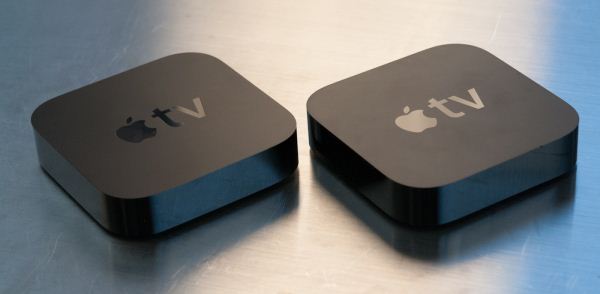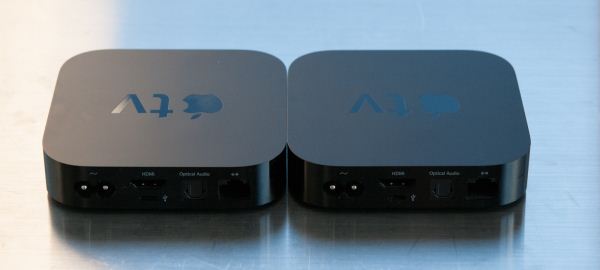Apple TV 3 (2012) Short Review - 1080p and better WiFi
by Brian Klug on March 21, 2012 4:21 PM ESTThe iPad (3) took front row during the recent launch extravaganza, however Apple also refreshed their Apple TV with a new model sporting a single core A5 SoC and some other noteworthy tweaks. We've spent some time with the new model since its launch, and have found a few interesting new things lurking inside. In addition to decoding 1080p iTunes content as well as YouTube and Netflix streams, the new Apple TV also includes a second WiFi antenna with better gain, which translates to improved reception and network throughput.
Quick, from the photo above, can you tell which Apple TV is the third generation device? Externally, the Apple TV 3rd generation is virtually indistinguishable from the Apple TV 2nd generation. The new device keeps the exact same dimensions and mass, in fact, during my testing the only way to tell the two apart was to compare the model number at the bottom. This is pretty unsurprising for an Apple product cycle, where you see successive generations inherit the same external design even as internals evolve or change dramatically. On the box, the new Apple TV 3 now includes both a 1080p marking and an Energy Star logo, something the previous model didn't.
Ports on the backside are unsurprisingly identical as well, as are the material choices. I've managed to leave quite a few scratches in the back of my Apple TV 2 over time, and the same glossy (if somewhat scratch-prone) plastic rings the device. No doubt that plastic choice was made originally both for RF propagation characteristics (low density, probably low carbon) and also so that IR works in the front. The real change again is that the Apple TV 3 now supports 1080p50 and 1080p60 over HDMI, where the previous Apple TV 2 only supported 720p50 and 720p60 at maximum over HDMI. Ethernet is still 10/100, there's still a microUSB port for restoring and flashing, and full size optical TOSLINK.
At the risk of sounding redundant, the accessories and remote inside are the same as the Apple TV 2 as well, namely an aluminum IR remote and the same length power cable. I don't think Apple's neat little aluminum remote needed any changing, nor did the power cable, but it's worth noting. The obvious upside is that if you're upgrading, everything about the current setup (power cable, HDMI, and space required) has stayed the same. If you're as obsessive about having a neatly wired home theater cabinet or stand as I am, this is definitely an upside.


















37 Comments
View All Comments
nfineon - Wednesday, March 21, 2012 - link
This is exactly the review I was hoping to find, with a more technical explanation of the hardware underpinnings that Apple doesn't really care to advertise. I personally have 6 Apple TV's throughout the house in all the key rooms and we get tremendous usage out of the Apple TV. Sitting at the dinner table together being able to instantly share our photos and videos via airplay is very nice, but a lot of people also don't realize that you can facetime on the big screen using the airplay mirroring function (try FaceTime on a 100" Projector/LCD and your mother won't ever want to use the small screen again).It's good to hear the antenna gain as improved, and i was really really hoping they would bump up to 2 spacial streams to get us 130 mb/s as Airplay of 1080p videos takes 2-3 times longer to load from the iPhone 4s camera as compared to the traditional 720p. That would also necessitate a bump up in all the iPad/iPhone devices as well given that all of them are also limited to 65 mb/s.
But the #1 usage of the Apple TV's in our house is in streaming our movie/show collection from our Synology NAS in any format. You can't do this with the default firmware, which is why we use the FireCore firmware that keeps the same interface and functions as the original Apple TV while adding the ability to stream from any network device in any format. Also lets you install XBMC, plex and a few other handy tools if you want to go the extra mile but that alone has made the Apple TV increase in value considerably!
Brian Klug - Thursday, March 22, 2012 - link
I was hoping for 2 spatial stream WLAN connectivity as well, unfortunately it just isn't here yet.No doubt future revisions of the Apple TV will use either BCM43241 (which is 2x2:2 and dual-band), instead of the direct BCM4330 successor, BCM4334 (which is still 1 spatial stream, but built on 45nm instead of 4330's 65nm).
-Brian
Shaun-T - Thursday, March 22, 2012 - link
What I want to know is, why doesn't Apple allow the refresh rate to be 24fps on the Apple TV 3? I read somewhere that the Apple TV 2 only output at 25 or 30fps as 720p/24 wasn't an official standard, but 1080p/24 is.So now we have a device that supports 1080p and the content sold on iTunes is 1080p/24. As BluRay players and and modern HD televisions use this, I don't understand why the the Apple TV 3 only outputs at 25 or 30fps. In either of those refresh rates, you get a stutter every second or so when playing 24fps content. It's really annoying.
MGSsancho - Thursday, March 22, 2012 - link
This device is not for what apple calls videohpines who wan to play BD ISOs, DVD ISOs and the llike. It is designed to play anything found on iTunes. If you can get other stuff to play then that is just the gravy on top. For things that are actully useful (at least on current offerings) we are forced to jailbreak it. :)cjs150 - Friday, March 23, 2012 - link
What an incredible oversite (bit like Apple advertising the Ipad 3 as 4G in Europe when it is not).But given that Intel are/were (what is latest position) incapable of producing a chip which outputed at the correct frame rate either (unlike AMD) why should we be surprised.
BD frame rate are not exactly an obscure or new standard!
I guess I will just drop this off my list of things to buy at least until someone jailbreaks it and gets the right frame rate and XBMC on it
solipsism - Saturday, March 24, 2012 - link
Why doesn't Europe follow the ITU's definition of 4G?alpha64 - Friday, March 23, 2012 - link
Your comment in the third page, which reads:In addition, the Apple TV 3 also moves from Broadcom's BCM4329 802.11a/b/g/n and BT 2.0+EDR combo chip to BCM4330 802.11a/b/g/n and BT 4.0 combo chip which we've seen in the iPad 2, iPhone 4S, and countless other mobile devices.
Should say "we've seen in the iPad 3, iPhone 4S, ..."
The iPad 2 had the same BCM4329 as the iPad and iPhone 4:
http://www.ifixit.com/Teardown/iPad-2-Wi-Fi-Teardo...
jpcuve - Monday, March 26, 2012 - link
I purchased one too. Since the last upgrade it plays all my movies correctly (600+), with the subtitles.locust76 - Tuesday, March 27, 2012 - link
I have the new Apple TV and a 40-inch 1080p Sony LCD, and I definitely notice a new sharpness and realism to the images and video from iTunes.I think it's also worth mentioning what this thing can do outside of the iTunes ecosphere: I ripped the Star Wars Ep 4 Blu-Ray and compressed it down to iTunes-level specifications, but with almost 10 Mbit/s video bitrate and DD 5.1.
The Apple TV handled it with no problem, save for buffering issues which prevented me from skipping wildly throughout the movie without longer pauses. However, when the movie was playing, it played without stuttering with exceptional picture quality, considering I was running a video stream through it that was probably double Apple's intended bitrate...
kwrzesien - Wednesday, March 28, 2012 - link
Is this with wired Ethernet or Wi-Fi?